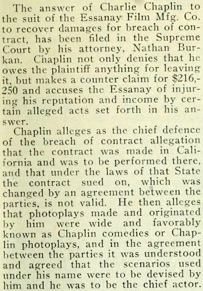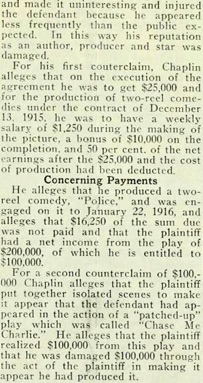Charlie Chaplin´s Burlesque on Carmen next previous
Burlesque on Carmen Clippings 100/101
Wid‘s Daily, New York, July 13, 1918.
Orpheum, exterior by day, marquee Charlie Chaplin in Carmen,
Cleveland, Ohio
(...) Motion Picture News, May 1, 1920
& Favorite Films Corporation
Charles Chaplin in His Comedy Super-Play
„Burlesque on Carmen“
with
An Original Musical Arrangement of Bizet‘s Carmen
US lobby card, re-release 1918, Library of Congress
„Chaplin Answers“
Editorial content. „Chaplin Answers Essanay in
Suit Over Broken Contract
Comedian Makes Counterclaim for $216,250
– Asserts His Reputation Was Damaged
The answer of Charlie Chaplin in the suit of the Essanay
Film Mfg. Co. to recover damages for breach
of contract, has been filed in the Supreme Court by his attorney,
Nathan Burkan. Chaplin not only denies that he owes
the plaintiff anything for leaving it, but makes a counter claim
for $216,000 and accuses the Essanay of injuring
his reputation and income by certain alleged acts set forth
in his answer.
Chaplin alleges as the chief defence of the breach of contract allegation that the contract was made in California
and was to be performed there, and that under the laws of that
State the contract sued on, which was changed
by an agreement between the parties, is not valid. He then
alleges that photoplays made and originated by him
were wide and favorably known as Chaplin comedies or Chaplin
photoplays, and in the agreement between the parties
it was understood and agreed that the scenarios used under
his name were to be devised by him and he was
to be the chief actor.
Agreement Outlined
He says the chief merit of his photoplays consists of his
skill in devising and arranging scenes so as to create
amusement. He alleges that under the agreement between
the parties for a year from January 1, 1915, he was
to direct the making of films and each production was not
to contain less than 1,000 feet. They were to be
distinctly designed as the ,Chaplin Brand‘ or ,Chaplin Comedy‘
and no films were to be released under that brand until
they had been approved by him. He says that in pursuance
of the contract he originated and created scenarios for
two-reel plays adapted to his style and talent.
Chaplin says that one of these plays was called Charlie
Chaplin‘s Burlesque on Carmen, which he completed
December 10, 1915. He alleges that the plaintiff in violation of
his rights as author caused the play to be lengthened
to a four-reel play and padded it by ,interpolated scenes
discarded by the defendant because they were
repetitions of scenes previously used and also rejected
because of inferiority and unsuitability.‘ He also
says the plaintiff caused isolated scenes to be taken for
this play in which ,one Turpin‘ who did not appear
in the original play, was a participant.
Claims Picture Was Altered
The plaintiff called the four-reel play a ,Chaplin Comedy‘
and after it had been unlawfully altered the plaintiff
advertised and sold it extensively throughout the United
States. He alleges that the interpretation destroyed
the merit of the production and made it uninteresting and
injured the defendant because he appeared less
frequently than the public expected. In this way his reputation
as an author, producer and star was damaged.
For his first counterclaim, Chaplin alleges that on the
execution of the agreement he was to get $25,000
and for the production of two-reel comedies under the contract
of December 13, 1915, he was to have a weekly salary
of $1,250 during the making of the picture, a bonus of $10,000
on the completion, and 50 per cent, on the net earnings
after the $25,000 and the cost of production had been deducted.
Concerning Payments
He alleges that he produced a two-reel comedy, Police,
and was engaged on it to January 22, 1916, and alleges
that $16,250 of the sum due was not paid and that the plaintiff
had a net income from the play of $200,000, of which
he is entitled to $100,000.
For a second counterclaim of $100,000 Chaplin alleges
that the plaintiff put together isolated scenes to make
it appear that the defendant had appeared in the action of a
,patched-up‘ play which was called Chase Me Charlie.
He alleges that the plaintiff realized $100,000 from this play
and that he was damaged $100,000 through the act of
the plaintiff in making it appear he had produced it.“
Counterclaim.
Essanay‘s Carmen Fake.
Charlie Chaplin‘s Burlesque on Carmen.
Police.
Chase Me Charlie.
Redaktioneller Inhalt
Charlie Chaplin´s Burlesque on Carmen next previous









